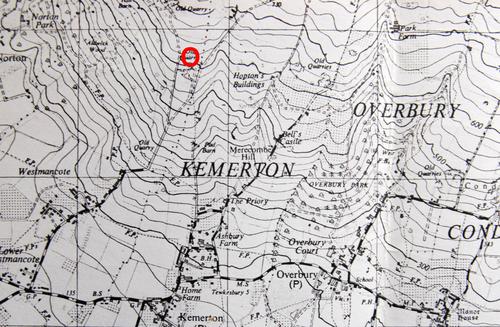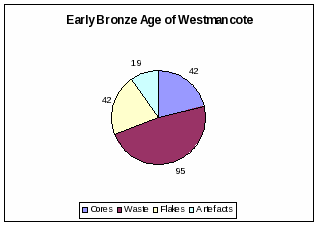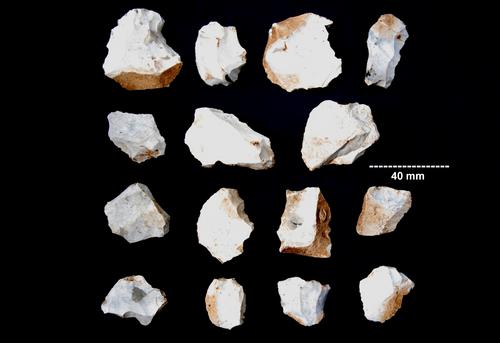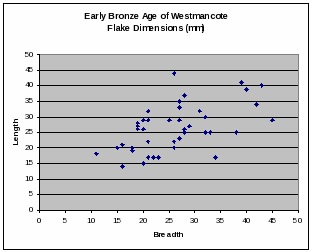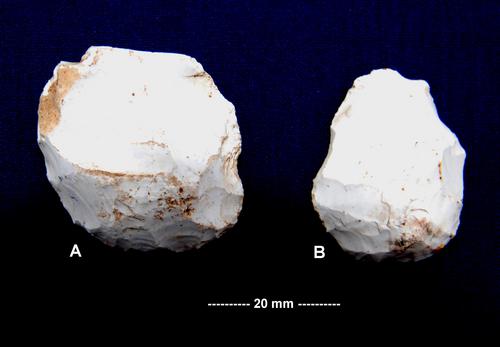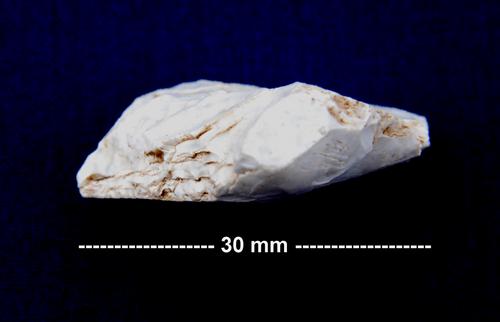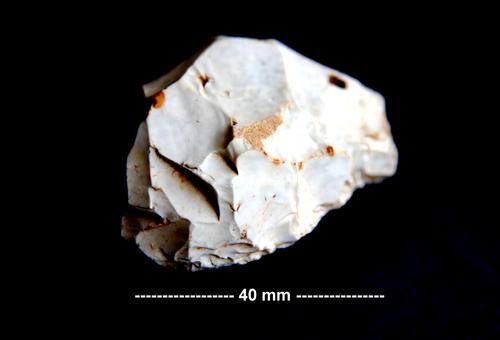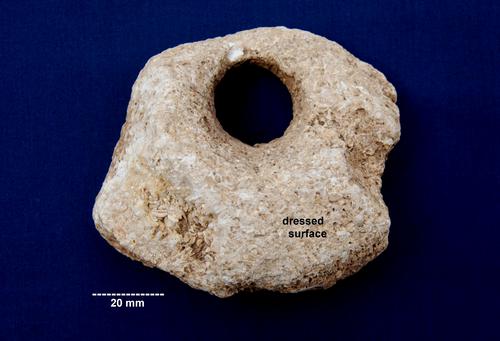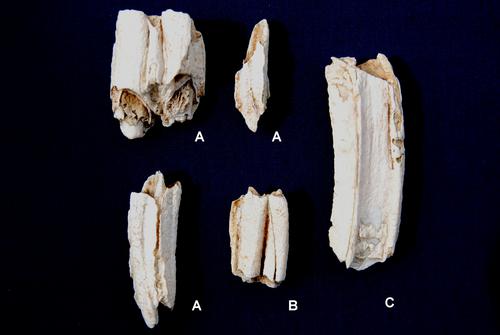An early Bronze Age flint scatter on the limestone dip-slope of Bredon Hill Worcestershire
P.F. Whitehead
Moor Leys, Little Comberton, Pershore, Worcestershire, WR10 3EH. Email: paul@thewhiteheads.eu
Introduction
During the second half of 1974 I observed a previously undocumented surface flint scatter near the southern limit of the Bredon Hill Oolitic Limestone at Upper Westmancote in the parish of Bredon. The scatter of mostly small inconspicuous fragments was centred at SO 94613858 (Fig. 1) to the east of the King and Queen Stones at an altitude of some 192 m O.D. on an arable field. The purpose of this account is to place the information at the disposal of those interested in the history of Bredon Hill, one of Europe's foremost bio-cultural sites. The material evidence for this account is placed in the permanent care of Evesham Town Council's Almonry Museum.
The finds
The material comprises items of rock and mammalian tooth and bone. The eight mammalian items include five teeth which, on the basis of their position in relation to the other finds, uniform condition and surprisingly high degree of secondary calcification are considered broadly contemporaneous with the flint scatter. These belong to a small equid almost certainly horse, relatively small domestic ox and a sheep (Fig. 9). Of three small fragments of appendicular bone two are calcined and, whilst not confirmed, are likely to be from ruminants such as sheep. The lithic items (Fig. 2) comprise 198 pieces of flint and cherty flint, one burnt quartzite pebble with thermal fractures likely to be due to its use as a 'boiling stone' and one worn perforated dressed discoidal fragment of Oolitic Limestone which is regarded as a loom weight (Fig. 9).
The lithic assemblage
The 42 core remnants originate entirely from small flint pebbles. These are often coarse and cherty and of poor quality having sustained both fluvial dispersion and exposure in an open glacial environment. This has limited the quality of the workmanship although there is some evidence from the flakes (Fig. 3) that some larger better quality material was also employed; that their 'parental' cores have not been found is suggestive that what was found was generally the more intractable rejected material. It seems likely this reflects locally-sourced limitations rather than a selection of choice. It should be observed however that quarried chalk flint nodules were traded into the Bredon Hill area during the Bronze Age (P.F. Whitehead, in press).
The 19 artefacts are mostly fashioned from better quality flint. Sixteen of these are scrapers including distinctive small rounded scrapers (Fig. 5) with convex pressure-flaked working edges (illustrated in Watson, 1968). They are fashioned from either cores or flakes and the latter include side-scrapers with steeply-angled working edges, often in the order of 80 degrees. In some instances these have been undercut apparently by extended use on durable materials (Fig. 6). A typologically distinct example of this is the thick core-scraper shown as Fig. 7. One flake-scraper has a retouched concave notch in its working edge. The remaining artefacts include a well-made bilaterally symmetrical utilised core and two flakes with numerous minute traces of utilisation along the edge of one surface only.
The loom weight [Fig 8] is fashioned on a worn dressed discoidal fragment of Inferior Oolitic Limestone with a perforation smoothly countersunk from both sides and therefore drilled. There are Bronze Age parallels in Britain and Ireland.
The age of the assemblage
Taken together the artefacts suggest a Bronze Age date (ca BC2200-BC750) and during November 1993 Dr Jill Cook of the British Museum confirmed that they could be assigned a position in the early Bronze Age. The loom weight is regarded as contemporaneous with the flints and parallels for it are known from Bronze Age Britain.
Relationship of the assemblage to the known archaeology of Bredon Hill
The Bronze Age is well represented in the documented history of Bredon Hill with abundant material and physical evidence for settled and semi-settled communities, especially later in the Bronze Age along the warmer low southern footslopes (Britnell, 1975; Dinn & Evans, 1990, Hughes et al., 2007). Up to now evidence for Bronze Age settlement has not been documented for the hill plateau and it is clear that settlement, possibly seasonal, did occur on the warm favourable soils of the southernmost limestone. What is especially interesting is the proximity of this site to the King and Queen Stones, a Bronze Age barrow, and other features (Hoggard, 1999) representing this period of prehistory and contributing strongly to the special character of Bredon Hill.
Acknowledgements
I am grateful to The Overbury Estate for making this study possible and to Dr Jill Cook for casting her experienced eye over the artefacts.
References
Britnell, W.J., 1975. An interim report upon excavations at Beckford, 1972-1974. Vale of Evesham Historical Society Research Papers 5:1-11.
Dinn, J. & Evans, J. 1990. Aston Mill Farm, Kemerton: excavations of a ring-ditch, middle Iron Age enclosures, and a Grubenhaus. Transactions of the Worcestershire Archaeological Society 12:5-66.
Hoggard, B. 1999. Bredon Hill: a guide to its archaeology, history folklore and villages. pp. i-xvi, 1-76. Logaston Press.
Hughes, J., Jackson, R. & Hunt, C. 2007. Unlocking the past: the story of Worcestershire's archaeology revealed through quarrying. pp.1-17. Worcestershire Historic Environment and Archaeology Service.
Watson, W. 1968. Flint implements. pp.1-108, three tables. British Museum.
Note: Lithics, the Journal of the Lithics Studies Society, contains a wide range of academic papers on stone tools.
Image
Fig. 1. Map showing site of flint scatter
Fig. 2. Proportions of cores, waste, flakes and artefacts in the Westmancote flint scatter.
Fig. 3. Fifteen struck unutilised flakes
Fig. 4. Metrical attributes of forty struck unutilised flakes.
Fig. 5. Disc-like convex flake-scrapers showing working edges developed by controlled pressure flaking. The edge of item B is retouched virtually all round. Positioned with points of percussion apical. © P.F. Whitehead.
Fig. 6. Flake scraper with the concave working edge
Fig. 7. Thick discoidal core-scraper
Fig. 8. Oolitic Limestone loom weight
Fig. 9. Teeth of livestock associated with the Bronze Age flint scatter at Westmancote. A: domestic ox Bos taurus L.; B: Sheep Ovis aries L. (probably not goat); C: horse Equus caballus L. The high degree of secondary calcification of all of the teeth results from some 4000 years of exposure in a calcareous substrate. P.F. Whitehead.
